All About Panel Surveys: 5 Panel Survey Examples and More
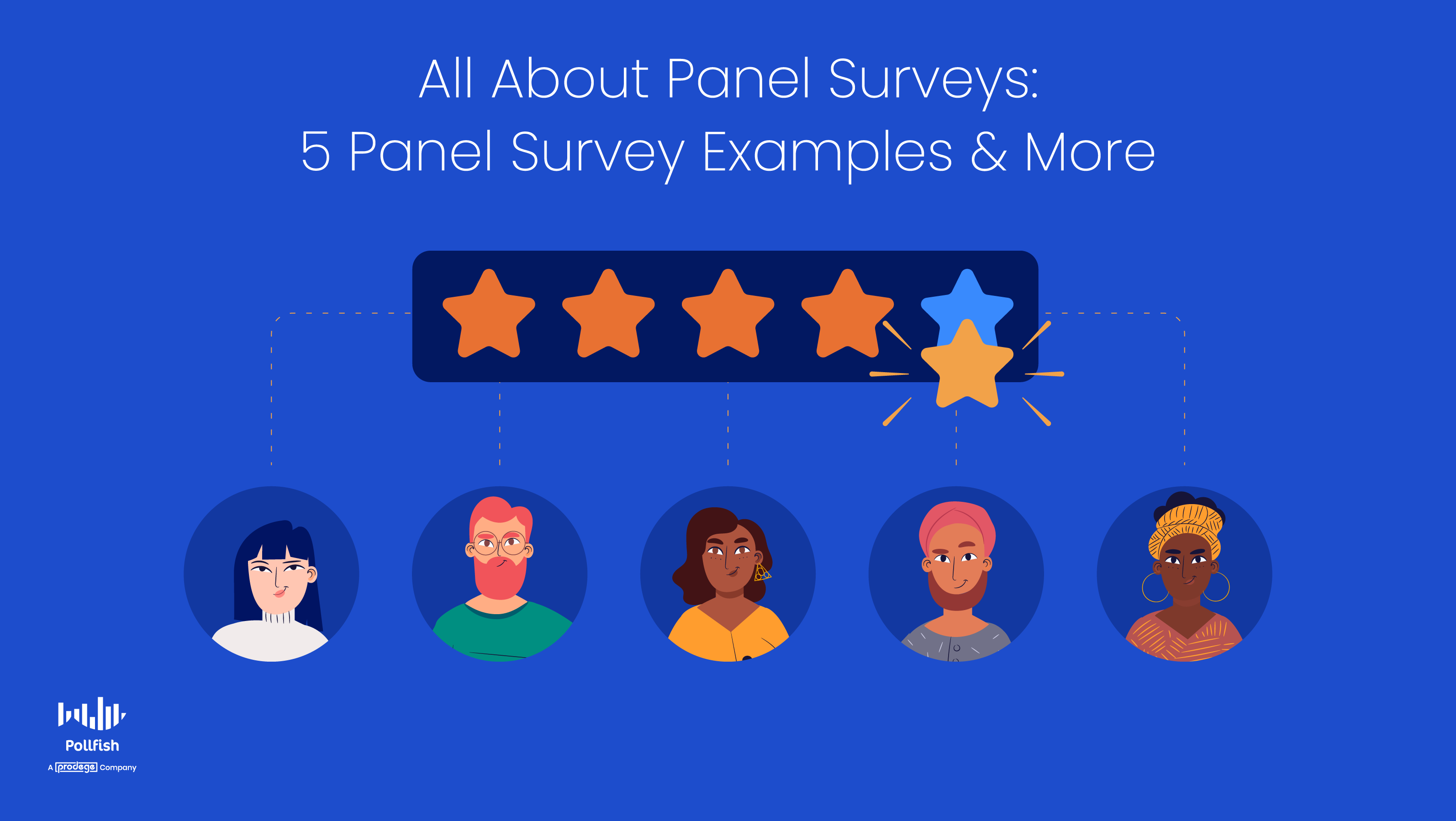
A survey panel also referred to as a panel survey, is a common research method used to gain insights from the same group of participants over a certain period.
This technique relies on examining research participants who join a market research study voluntarily. Aside from this, the participants are pre-recruited by researchers, to ensure they fit the respondent criteria they set for a particular research project.
This kind of research technique may appear to be a buzzword, given its prevalence in the market research space. However, whether it is useful and effective for your market research is entirely up to your research preferences and campaign needs.
Nonetheless, it is crucial to understand what a panel survey is before you can decide on whether you ought to implement it into your research strategy or not. Or, perhaps you want to use it in conjunction with another research method.
Either way, you should have a holistic view of everything this research method entails. This includes comparing it with random organic sampling and online surveys. Luckily, this guide provides all of this information and more.
This guide explores panel surveys, explaining them in full depth, along with their pros and cons, 5 examples of them and a comparative analysis of random sampling and survey panels.
Note: If you’re looking to do market research without the drawbacks of conducting panel surveys, try Pollfish. Our unique methodology guarantees authentic high-quality data, and it’s a fast and reliable way to survey targeted (yet randomized) people while they’re already engaged on their devices.
All About Panel Surveys: Table of Contents
- Defining Panel Surveys
- Panel Surveys: A Kind of Longitudinal Study
- Using Panelists in Your Target Market
- What to Study with a Panel Survey
- The Importance of Panel Surveys
- Panel Survey Examples: What Do Researchers Use Panels For?
- Pros & Cons: The Advantages and Drawbacks of Panel Surveys
- Organic Sampling: A Better Alternative to Panel Surveys
Defining Panel Surveys
Also called survey panels, panel surveys are a distinct form of market research that relies solely on panels to carry out the research study, as its name suggests.
Thus, it’s key to understand what the term “panel” means in the context of market research. A panel is a selection of participants who help researchers conduct market research by providing them with feedback on various studies.
The panelists do not join the study randomly, rather they are pre-recruited and pre-screened, based on the researcher’s panel needs and criteria.
A kind of research panel, a survey panel operates in the same way, except that it is strictly used within survey campaigns. As such, this panel is used for survey research alone, as opposed to other methods of panel usage.
Panels can be used in various research settings, including the following:
- One-on-one interviews
- Focus groups
- Survey studies
- All 6 main types of research, which include
- Exploratory research
- Correlational research
- Causal research
- Descriptive research
- Experimental research
- Explanatory research
- Field research
In the context of this guide, we’re going to focus on panels used in survey research alone. Hence, they are called survey panels, or panel surveys.
One of many market research techniques, this kind of research process uses a consistent group of participants, with the researchers returning to them repeatedly, either for a single survey campaign, which can require using multiple surveys or for multiple campaigns.
Panel Surveys: A Kind of Longitudinal Study
It is important to know that when referred to as a panel survey, this kind of research method is known as a longitudinal study. As such, this process is paired with longitudinal surveys.
This type of research study is often associated with correlational research.
As a type of longitudinal study, panel surveys involve correlational research because they examine the relationship between variables over an extended period. The period itself can vary.
As such, this kind of research method can be conducted in the following ways, occurring throughout:
- Weeks
- Months
- Years
- Decades
Regardless of the time dedicated to performing this research, it always involves the same survey target audience. By surveying the panelists at different points in time, researchers can glean a wide variety of changes and consistencies within their research subjects, aka the panelists.
Using Panelists in Your Target Market
While the panel remains the same, the topic(s) that can be scrutinized are virtually limitless.
For market research, the topics deal with a business’s target market. As such, all members of the panel survey must also have the qualities of those in your target market.
You can perform panel survey studies by zeroing in on your target market’s various market segments and customer personas. These are more distinct and defined groups of people who fall under your customer base.

This is the ideal way to conduct this kind of research and many others, as your target market can include a wide range of subgroups, whether they differ based on the following categories:
- Geographical locations
- Demographics
- This involves groupings based on gender, age, income level, ethnicity, employment type, education, etc.
- Psychographics
- This involves their attitudes, lifestyles, aspirations, values and other psychological criteria.
- It also involves whether they engage in a particular customer behavior.
- Firmographic
- This label is particular to studying a panel of business personnel, which you may do in B2B research.
- As such, it requires running B2B surveys.
Whichever categories you intend to group your panelists into, remember that they must fit into the qualities of your target market, as this group is the population of people most likely to purchase from your business.
What to Study with a Panel Survey
As aforementioned, you can explore a wide variety of topics in your panel survey. The following list enumerates some of these topics. Note that this is not a comprehensive list, as various other topics of concern may crop up, depending on your business, your customers and your research needs.
Here’s what this kind of research method allows you to study:
- Changing attitudes, opinions and sentiments
- Changes in customer buying behavior
- Changes in customer lifestyles
- Changes to consumer preferences
- Developments in your target market needs
- How your target market views your competitors
- The willingness of your customers to make repeat purchases
- Gaining a more in-depth glance at your market segments and customer personas
- Performing time-based research, such as longitudinal studies, retrospective studies and prospective studies
- Acquiring a snapshot of the present through cross-sectional studies
In this post, we’ll look at five-panel survey examples, which delve deeper into some of the topics on this list. But first, we’ll explain why this research method is important for researchers and their market research campaigns.
The Importance of Panel Surveys
Panel surveys are important for a variety of reasons. Some of these reasons may hold more weight than others, depending on your research needs and preferences.
Firstly, these panels are ideal for longitudinal research, as the same group of participants agreed to partake in your study. You would make it known that they would be used in continuous studies.
Aside from facilitating longitudinal studies, panel surveys are also ideal for another time-based research campaign: retrospective studies. As such, these panels aid researchers in completing their retrospective surveys.
This kind of study is used to examine changes over a long period, except the survey itself is only administered once. That’s because retrospective studies invoke occurrences from the participants’ past, whether they are experiences, inclinations, feelings, or attitudes.
The study may ask participants to compare past phenomena with how they feel in the present. The purpose is to study historical data and compare it with the present.
Panel surveys are also necessary for prospective studies, which also can last for years and study changes and developments. However, unlike retrospective studies, they involve participants who do not have a certain outcome. Instead, prospective studies seek to study people before they develop a certain outcome, such as a disease or a new shopping habit.
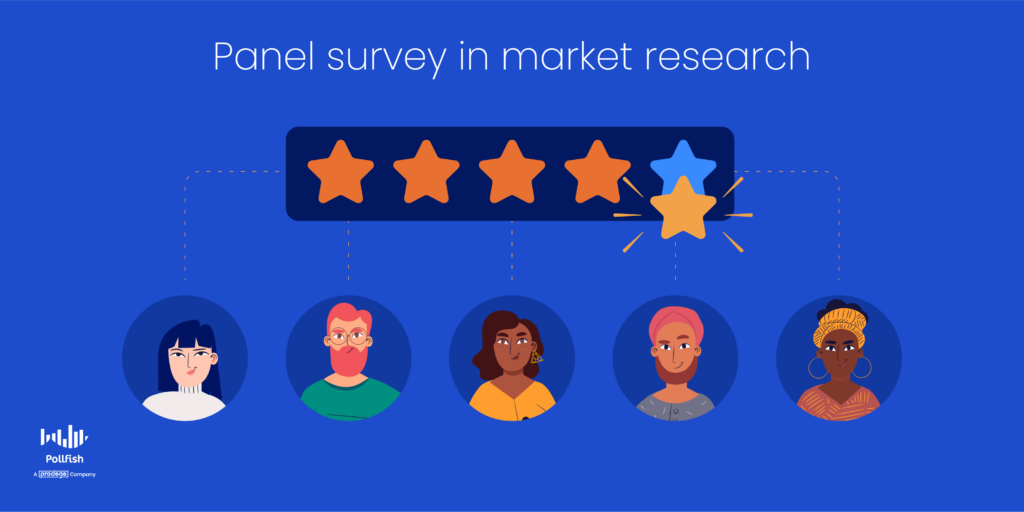
Aside from enabling researchers to study changes, these panels also make it possible to conduct cross-sectional studies, which are different from the prior three kinds of research studies — longitudinal, retrospective and prospective studies. Nonetheless, cross-sectional studies are still one of the key survey research methods.
As opposed to studying survey subjects at multiple points in time, a cross-sectional study entails gathering research about a particular population at one fixed point in time. Because of this, this type of research method is often referred to as a snapshot of a studied population.
This kind of study is conducted by using cross-sectional surveys, which are designed specifically for the cross-sectional model and can be sent to your panelists. Although cross-sectional studies don’t require a panel survey, given that they focus on a single point in time instead of several to examine changes, they can still be administered via these panels.
That’s because you can recruit panels for virtually any study, whether it includes partaking in a survey, an in-person interview, field research, or a focus group. Thus, panel surveys are not limited to any form of study, making them multifunctional.
This grants plenty of convenience to researchers, especially those bogged down by various other tasks they have to uphold, instead of putting together a group of respondents.
Panel surveys are especially important, as they provide an ongoing sampling pool of participants, which researchers can turn to whenever they seek to conduct more research. This can be to jump-start a new research campaign or conduct further research for an ongoing campaign.
This constant access to a sampling pool can also assist researchers who initially thought they had enough data, only to later discover they need more information. After all, if the panelists have already opted in, there is no need to seek out participants any further.
Panel surveys are also useful due to the quality of the panelists. Although identifying and vetting panel members may take some time, the result is a quality survey panel, one that ticks off all the panelist criteria you have. With this, you can mitigate fraud and rest assured you’re studying the correct populations.
All in all, panel surveys are useful for a variety of market research campaigns and come with a good share of benefits, despite some of their shortcomings.
Panel Survey Examples: What Do Researchers Use Panels For?
Now, let’s get to the heart of these panels, by going over what they can consist of, when, where, and how to use them.
The best way to explain the uses of a panel survey is by providing several panel survey examples. In this section, we’ll review five examples of when panel surveys can be used to good effect.
This will allow you to understand how panels work, along with some of their best-case scenarios for usage.
Example #1: Tracking Changes Over Time
Given that studying changes over time is the main purpose of leveraging a survey panel, it’s key to review this use case.
As such, one of the strongest examples of a panel survey is when researchers ask the same question(s) to a group of the same participants over a long period.
For example, if you were conducting a sociological experiment to understand if (or how) age correlates with wealth, you can set up a survey that studies panelists on the following:
- Income
- Expenses
- Assets
- Changes in employment
- Willingness to change jobs
- Willingness to switch job fields
A survey covering this topic ought to be conducted every two years, possibly spanning a decade (or more if need be).
That way, you can track changes relative to the scope of the issue you’re researching. Given that people typically stay at a job for about two years, it is key to follow up every two years on this research subject.
However, this has changed due to the Great Resignation, which saw the largest exodus of employees quitting their jobs in recent history.
The Great Resignation is not slowing down any time soon, with large numbers of people seeking better pay and benefits, along with the rise in job openings and remote work. This makes it much easier to switch jobs.
As such, the length of time you devote to tracking changes will depend on the circumstances of your study.
Alternatively, if you run a business, you’ll need to acquire ongoing insights into the market – and into audience behavior. For example, if your gym wear company wants to track the fitness habits of people over the year, a panel can be questioned every three months. You can run surveys with the same questions about how long people exercise, where they exercise, and how they do so.
For any business endeavor, you can implement the brand tracking survey, which allows you to track any changes that deal with your brand. This involves studying how your business is perceived, how in-demand its offerings are, what concerns your target market has that your business can address and much more.
Example #2: User Experience Research
Another common example of using a panel survey is for UX and UI design research. While UI refers specifically to designing web experiences, UX is far broader.
User experience can refer to a wide range of experiences that your customers encounter when interacting with a product, digital experience, or service. As such, it covers a wide range of aspects, all of which have some impact on how users experience your business’s offerings.
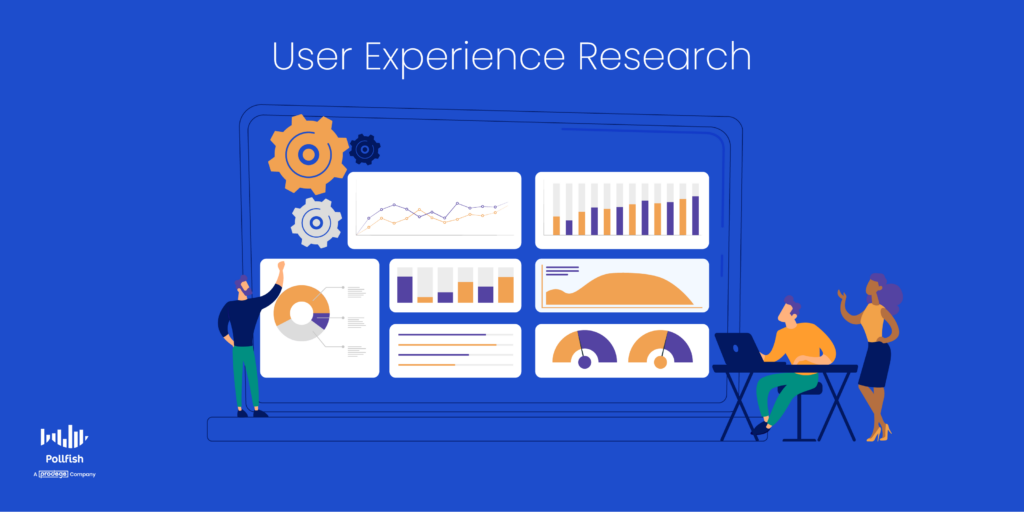
You can use these aspects as key considerations for driving your UX research. The following lists the four key components of user experience, which you should use in your research:
- Value: Does this experience give customers value?
- You can ask your panel whether a certain product, service, or digital experience provides them use and how so.
- It is key to study how your offerings can be made more valuable.
- Also, you should inquire about the products/services that your customers don’t find useful.
- Function: Does a product or product feature work?
- Ask your panel whether there are any bugs or glitches in how a product, feature, or service works.
- You can also study whether new needs arise in terms of your product’s functionalities.
- Usability: Is it easy to use?
- While your offerings may provide value, ask your customers whether they are easy to use, regularly.
- Study if your offerings can be made simpler over time.
- Also, look into whether customers seek other ways to access your offerings.
- For example: different devices, operating systems, web and app access
- General impression: Is it pleasant to use?
- Track changes to the overall sentiment towards your products, services and business at large.
- Ask your customers whether your offerings delight them or upset them.
- Ask customers to reveal anything else they’d like to see from your business to improve their UX.
When a company is building an app or a digital product, they want to gauge the customer experience as they go.
While usability testing (i.e. tracking how a person interacts with a specific feature), is often done using different methods, you can conduct qualitative research about design and experience by way of panel surveys.
The benefit of a panel survey here is that the participants remain constant – which removes a key variable.
Additionally, you can select panel participants based on their background or expertise, which will allow your pool to answer questions in a way that adds value to your product development process.
Example #3: Customer Satisfaction Surveys
Customer satisfaction is central to keeping your business alive, whether you want to release new products or build a steady base of loyal customers. As such, you can use panels to keep a watchful eye on your customers’ satisfaction with your business.
Doing so will allow you to increase your customer lifetime value, a metric that measures the total monetary value a customer will bring to a business during their relationship with the business throughout their lifetime.
If you want to gauge customer satisfaction and positive/negative sentiment over the lifetime of their interactions with your offering, use a select group of long-term customers and ask them questions periodically about your value proposition.

Use a customer satisfaction survey for this campaign, which can be framed to reveal hidden sentiments, or can be explicitly focused on asking how satisfied they are with what you offer.
For example, use the following questions/considerations to measure customer satisfaction:
- On a scale of 1-10, how satisfied are you with [a product, service, experience]?
- A rating scale question
- What would you change about [a product, service, experience, or your company] if you could?
- Open-ended question
- How easy was it for you to [do something] with our product?
- Options include a scale of extremely easy to extremely difficult
- This is a Likert scale question,
- How would you rate your experience with our new [a product, service, experience]]?
- This can be a Likert scale.
- Or, it can involve multiple choices of varying answers.
In this panel survey example, the business would be able to track patterns of customer happiness over time – for example, to see whether features continue to add value months or years after the customer signs up. And you can incentivize participation with gifts, reduced subscription fees, or extra services.
Consider discussing the following topics with your panel:
- What are their overall thoughts about your business?
- How do they receive product updates? (Poorly, well, etc.)
- What kind of value does your business provide and where does it lack in value?
- What else can you do to delight your customers?
Example #4: Employee Engagement
Another crucial panel survey example deals with studying your human capital, aka, your employees. After all, it is the employees that allow your business to function daily.
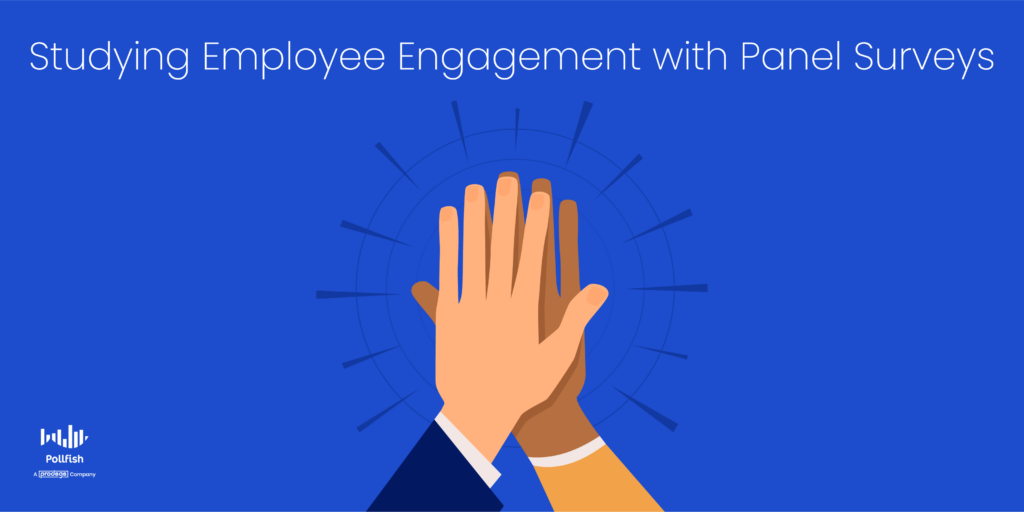
As such, your business needs to track employee engagement and team morale. In essence, here, your staff are the members of the panel survey – and you might survey them every week, month, quarter, or year. In this case, you’re surveying the same people about issues that answer the following:
- Are employees engaged at work, or do they have low morale?
- Do employees enjoy their work?
- Are they meeting their goals?
- Do they understand the company’s mission?
- Do they understand the company roadmap and high-level goals for the coming weeks and quarters?
- Are they happy with their compensation?
- Where can the company improve?
If this is the type of panel survey you’re looking for, there are plenty of surveys that are specialized for human resources and employee engagement purposes.
This includes the following surveys:
- The employee satisfaction survey
- Used specifically to measure satisfaction, this survey focuses on what customers like and dislike about their jobs and the company,
- The employee feedback survey
- This is a general survey that should handle high-level topics.
- The employee burnout survey
- This survey focuses on the negative aspects of employees’ jobs and your company.
- You can use it to avoid burnout by asking them what they’d like to see change in their employment, workflows, job processes, schedules, etc.
- The employee recognition survey
- This is conducted to measure and understand the degree of employee recognition within a business.
- It gauges the perception of recognition that employees feel they have from their managers, peers and the company at large.
- The eNPS survey
- This functions the same way as a Net Promoter Score survey but for employees.
- Employees are asked how likely they are to recommend their company to others, on a scale of 1-10.
- The employee retention survey
- This is used as an instrument to retain employees.
- It delves into the topics that business owners and HR workers need to understand, to forge ideal work environments and cater to the needs of their employees,
Example #5: Customer Loyalty
It takes years to build solid consumer loyalty, which is a must, given that it is the core of the aforementioned customer lifetime value. By retaining your customers, you’ll spend less on attempting to acquire new ones, have a steady pool of revenue and maintain a good brand reputation.
Your panel survey can help you keep track of your customer loyalty. As you gain their insights, you’ll discover how you can raise their loyalty to your brand. To do so, use a market research platform that offers a brand tracker.
This tool allows you to keep track of a variety of brand issues throughout the year and beyond. It enables you to uncover whether there are any shafts in your brand perception or reactions to your marketing campaigns.
Consider tracking the following on customer loyalty:
- What excites my target market about your offerings?
- What kind of brand news incites the most interest?
- Which segments of customers are most likely to make repeat purchases?
- Which customer groups are the most loyal to your brand?
- Which actions and offerings inspire loyalty to your brand?
Pros & Cons: The Advantages and Drawbacks of Panel Surveys
Now, it’s time to analyze the advantages and disadvantages of using panel surveys for your market research.
One of the primary advantages of a panel survey is that the participants learn to trust the researchers, and therefore may be open to deeper and more truthful answers.
In addition, this ongoing relationship can allow researchers to dig deeper with follow-up questions.
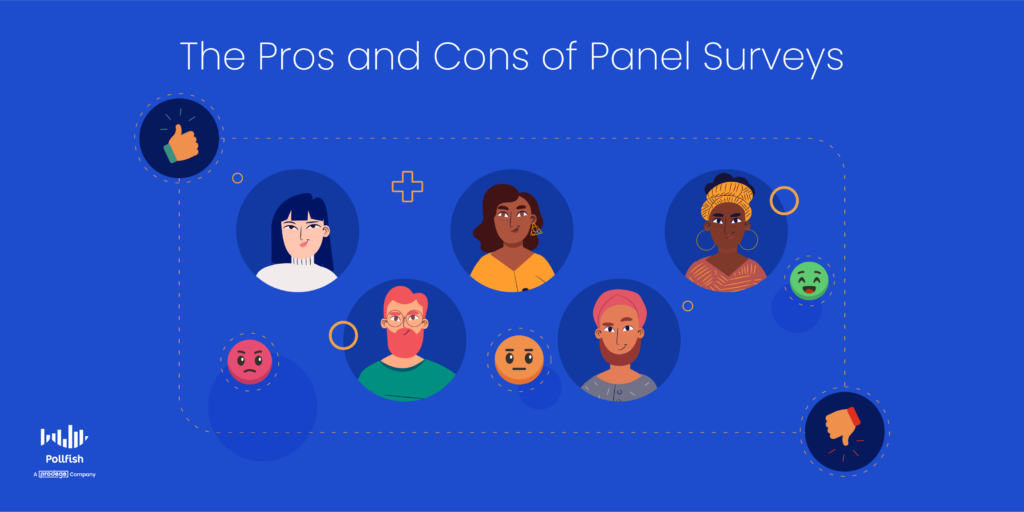
Another advantage is that with screening having occurred at the start of the research, all following surveys are quicker to carry out than starting from scratch.
However, the disadvantages of panel surveys include:
- Panel conditioning: When you’re surveying the same people repeatedly, previous surveys might influence their responses and/or behavior. For example, if they know a certain question triggers a longer process, they may choose an answer that offers the path of least resistance. Or if you’re asking about a particular activity, like eating donuts, they may eat less (or more) thereafter.
Note: Furthermore, panel surveys don’t tend to occur within a “natural” setting, and therefore the artificial environment might affect thought processes and responses to questions. - Panel fatigue: If a person feels like a pay-off for participating in a panel survey is no longer worth the effort, the quality of their response may drop. This leads to incomplete or poor-quality survey responses, and survey “straight-lining” – i.e. answering the same to every question.
- Declining participation: Over time, inevitably, participants will drop out of the process – either due to panel fatigue, or other reasons. This will damage the quality and depth of your data.
And with survey panels, you run the risk of accidentally signing up “professional” panelists – especially when there are cash-based incentives on offer. Though screening should be designed to pick up these people before they enter the process, they’re adept at slipping through the net.
Organic Sampling: A Better Alternative to Panel Surveys
With increased pressure on people’s time, survey response rates have been decreasing. It’s harder than ever to guarantee consistent high-quality data, and as conventional survey companies scramble to include as many willing participants as possible, the quality reduces yet further.
At Pollfish, we don’t use conventional panels. Our unique methodology, called Random Device Engagement (RDE) uses the organic sampling approach for finding and procuring survey participants.
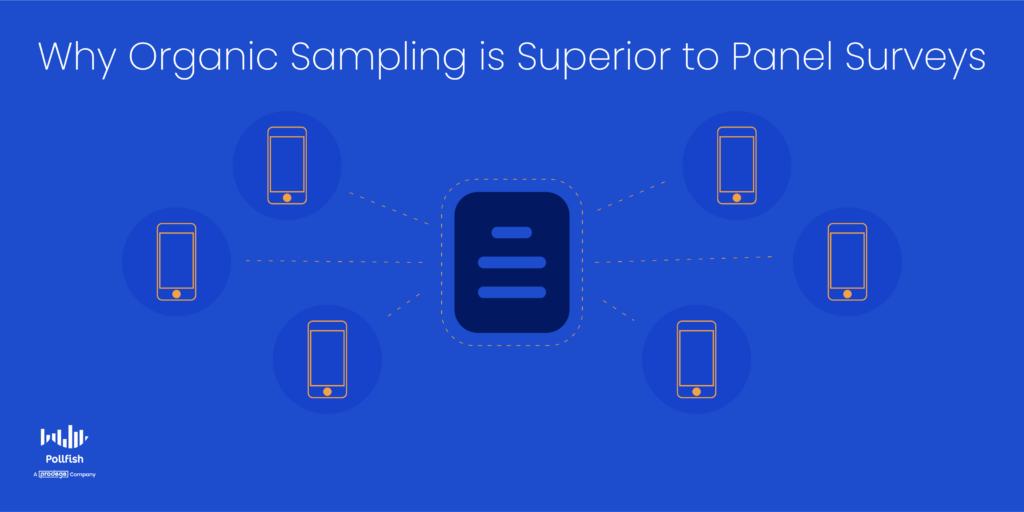
A kind of organic probability sampling, RDE polling relies on advertising networks and other device portals to engage potential respondents wherever they are voluntarily. This includes a variety of digital platforms and properties, such as:
- Mobile sites
- Apps
- Website
- Mobile games
All respondents gathered via the RDE method have no biases, as they are not pre-recruited and therefore face less pressure to answer things in a certain way. Due to this, they are less subject to a wide host of survey biases.
This includes the following survey biases:
- Sampling bias: This bias occurs when the respondent selection process, specifically when a survey sample is not chosen at random.
- This leads to under or overrepresentation of a certain segment of your survey target population, as only certain types of respondents are going to partake, while others aren’t.
- Acquiesce bias: Also called agreement bias, this occurs when respondents gravitate towards positive or agreeable answers.
- In this bias, respondents feel more social pressure to answer in a particular way, as their identities are known in panel surveys.
Organic sampling and Random Device Engagement obliterate these two (and other) biases. That’s because this process is completely randomized, stamping out sampling bias. Not only does it reach people randomly, but on Pollfish, this method is paired with our state-of-the-art survey platform.
Our online survey platform reaches specific populations based on demographics, psychographics and specific screening questions you can input. This ensures you’ll reach all the required target audiences to partake in your study.
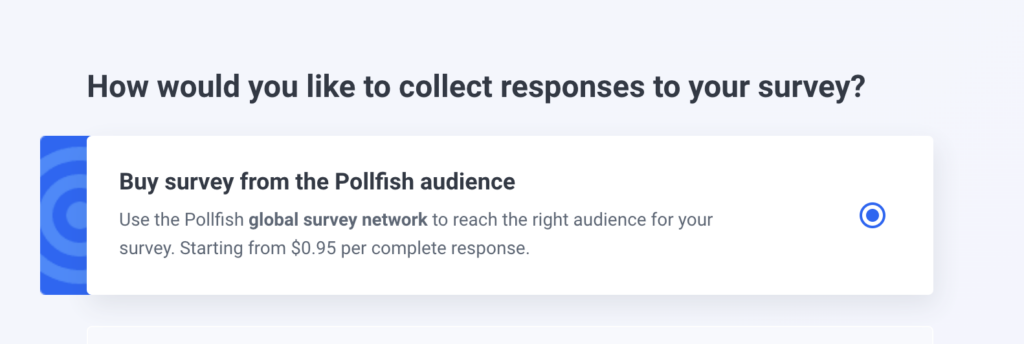
Aside from reaching respondents organically and randomly, the respondents are completely anonymous. They don’t need to provide their names, contact information, or any identification to take a survey. Instead, they are simply reached and opted in.
They may also have the option of gaining survey incentives. This eliminates virtually all forms of acquiescence bias, as there is no pressure to provide certain answers over others.
Each screened participant has a unique ID, which prevents them from taking the same survey more than once, weeding out bias and survey fraud.
When working with Pollfish, you don’t need to use conventional panels – which are slow and subject to conditioning, fatigue, and declining participation. Instead, get authentic insights from our pool of over 250 million people (and growing) – who are already engaged on their devices and ready to participate.
As such, organic sampling, coupled with a potent online survey platform like Pollfish, provides a better market research option over panel surveys.
A panel survey is a type of survey method that involves repeated interviews of a group of people over a specific period of time. A longitudinal study is another term used to describe panel survey. It refers to any study that examines the same group of people over a period of time. Panel participants often learn to trust the researcher and may reveal deeper, most honest insights. This type of survey is also a good way to track progress or evolution over time. Panel fatigue occurs when the participant no longer feels that the reward for participating in the panel is worth it. If panel fatigue occurs, the participant may not give deep answers, but instead try to answer the questions as quickly as possible. When interviewing the same people repeatedly, the answers to previous surveys may influence their behavior by causing them to reflect on activities that they previously gave little thought to. This influence is known as panel conditioning.Frequently asked questions
What is a panel survey?
What is a longitudinal study?
What are the benefits of panel surveys?
What is panel fatigue?
How can panel surveys influence participant behavior?
Pollfish Marketing Team
Ready to Try Pollfish?
Create your survey with AI, target high-quality respondents starting at $0.95 per complete, and start getting results in just minutes in real-time. From running a simple product concept survey to managing a constant stream of trackers for dozens of clients in dozens of countries, we’ve got you.

